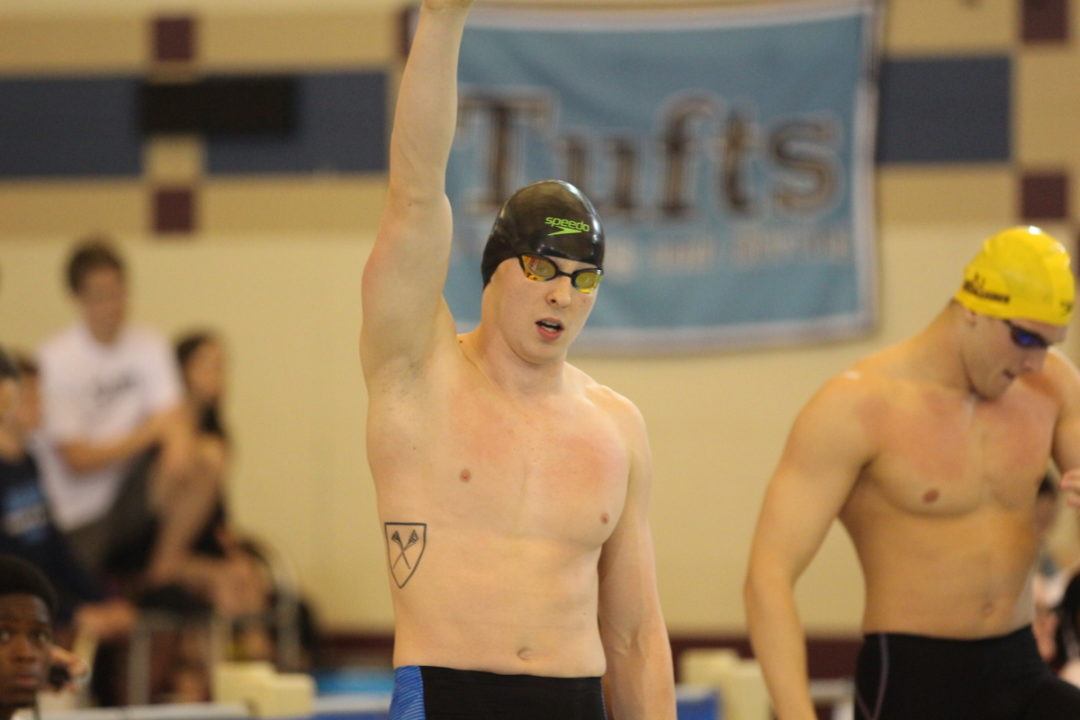TritonWear and SwimSwam bring you the best in swimming race analysis for the 2018 Men’s NCAA DIII Swimming and Diving Championships. With the power of TritonWear, you can access 12+ metrics for all athletes simultaneously, display the results in real-time to unlimited screens on deck, and review later in an easy to use interface for monitoring progress and identifying trends over time. See all Tritonwear Race Analysis here.
Thanks to a request from our amazing fans, we decided to analyze the men’s 50y freestyle. It may have been a short and fast race, but was not the least bit disappointing. If there are events you’d like us to analyze, let us know! Twitter @tritonwear or email to [email protected].
Emory’s two-time defending champion Oliver Smith broke the 2012 NCAA record by a hundredth of a second in the prelims, landing him in the top seed for the final. He defended his title against teammate Trey Kolleck, Loras’ Isaac Casey, Tuft’s Roger Gu, UW Stevens Point’s Jack Englehardt, Denison’s Kymani Senior and Zachary Wagner, and W&L’s Thomas Thetford.
Smith led the race right off the dive, breaking out ahead of the field before charging on to swim at a speed way above average, going at 2.46 m/s compared to the average of 2.36 m/s on the first lap.
One point of interest in this race is that while Smith’s speed was outmatched, he didn’t have the most efficient strokes with his stroke rate falling in the mid-range. It was Casey, who came in 3rd, who had the most efficient strokes, producing the highest DPS and stroke index in both laps, and Kolleck, who placed 5th, who had the fastest stroke rate. So why did neither of them place in the top 2?
While Casey generated the greatest distance in each of his strokes, he lost ground with his slow stroke rate and turn time. Improving his turn, as well as upping his tempo – perhaps even adding in a stroke or two – while maintaining his stroke power, could have brought him in below the 20-second mark.
Conversely, Kolleck’s stroke turnovers were too fast. He was rushing to get in his strokes but not gaining as much distance with each pull. He had the lowest DPS on the first lap, and though he was the only one to increase DPS on the second, it still fell on the lower end of the range.
Takeaways
In sprint events it is crucial to make every stroke count. This means finding the balance between stroke efficiency and turnover speed, maximizing distance in each pull without losing too much time in between.
Another takeaway is the importance of transitions, especially in short races, where the difference between first and last place isn’t even a full second. While Smith did produce the second highest stroke index (not far behind Casey’s), which definitely reinforced his lead, what gave him an even greater advantage was the way he optimized his walls.
Smith produced a faster turn time than most of his competitors, and spent the 2nd shortest time underwater on both laps, which by itself isn’t desirable. What makes him stand out is how he was able to break out ahead of everyone else within that shorter timeframe. He has clearly found a sweet spot between his time spent underwater and the speed he can produce there.
To dive into the numbers of each athlete yourself, use the interactive board below to see exactly how they performed across all metrics.
With 3 days left of the 2018 NCAA Swimming Championships, there will be more exciting races to look out for. Stay tuned for more race analysis!
VISIT THE TRITONWEAR HQ
LIKE TRITONWEAR ON FACEBOOK
FOLLOW TRITONWEAR ON TWITTER
FOLLOW TRITONWEAR ON INSTAGRAM
Swimming analysis is courtesy of Tritonwear, a SwimSwam partner.

